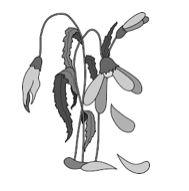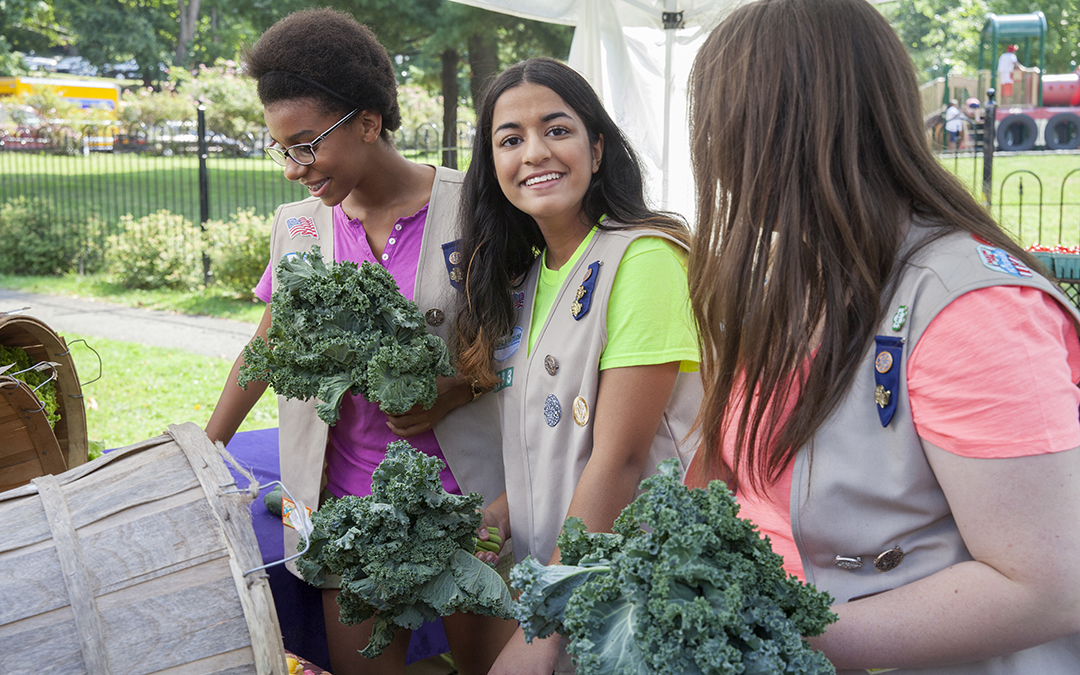The Gold Award is the highest award a Girl Scout can earn, and for good reason. More than a community service project, the Gold Award is based around a well-researched and sustainable Take Action project. Girls will be taking an issue they’re passionate about and making a big difference on a local, national, or even global scale, and they’re in charge every step of the way. So your girls have decided that they’re going to go for it—where do they even begin?
Start with a basic topic
When considering potential project ideas, Girl Scouts should think about the topics that interest them and the problem(s) they would like to address. Are they interested in helping shelter animals? Do they see a need for after-school tutoring programs at a neighborhood elementary school? Thinking about their skills, interests, and the needs of their community is the starting point for developing a Gold Award Take Action Project. Remember, earning the Gold Award is for each individual girl. It is not for her parents, Troop Leader, or anyone else. She needs to make sure that the topic she picks is something she is truly passionate about!
Gold Award projects start as a simple idea or budding passion and grow into meaningful projects. Each girl will brainstorm ideas, research the issues she is considering, investigate partnerships, and finally settle on a specific, actionable problem to solve before writing up her proposal. Rather than starting with a settled idea of what she wants to do, and hunting for a group that needs that project, here’s how a girl can turn her spark of an idea into an actionable, research-based project.
Next: research
Get out there and ask questions—lots of questions. Find knowledgeable people in the community and ask open-ended questions that encourage people to talk about the subject. Ask “why”—why is this issue a challenge? Why has it persisted for so long? Why haven’t previous efforts to address it been enough?
Girls will want to find community organizations committed to working in the same area(s) of interest and set up informational interviews with community resources and experts, or consider digging deeper in to the topic from their Bronze or Silver Award projects. Encourage her to look for local or national news articles on their topics—the more she learns, the clearer it will be which project to choose. Through this research, girls need to pay attention to places where it feels like there is still work that needs doing, discard ideas that are based in assumptions about the topic instead of facts, and take notes on the kind of support and information needed for the project to succeed.
Pro Tip: When you seek out knowledgeable people in your community, they would be great Project Advisors! They’re also known as Subject Matter Experts (SME).
Find the Root Cause
Why do the girls need to ask so many questions in their research? The goal is to identify a root cause: the reason (or reasons) why the original problem exists.

Let’s look at this sad, wilted flower. It is clear there is a problem. The flower head is drooping, the leaves are wilted. These two symptoms (or visible signs of an issue) make it clear there is a problem worth addressing, but do not tell us definitively what that problem might be. A possible short-term fix is to provide the flower with a stake to support it until it grows stronger. While this might help fix the symptom temporarily, if the underlying problem (Root Cause) is not addressed, the flower may still die.
The symptoms of an issue are easy to observe, but the root cause requires a little digging. To understand why the flower is dying, look at the roots—below the surface. Instead of mistaking the symptoms for the cause, research helps find the issue or issues that link all the symptoms together. Once the cause of the problem is identified, a plan can be created for sustainable actions to help the plant. The same is true for a Gold Award Project: based on the girl’s research phase, she will be able to design a Take Action project that addresses one or more of the root causes of her topic and create sustainable improvement.
- Symptom: Drooping flower, wilted leaves
- Problem: Plant is dying
- Possible Root Causes: lack of water, food, insect invasion, root bound, disease
How can mind mapping help?
A great activity to help girls with brainstorming and research is to create a mind map for any of the topics that interest her. A mind map is a visual display of ideas. Write the topic in the middle of the page. Ask multiple open ended “Why” questions to help populate the mind map. A mind map can be created using paper and pencil or a variety of online tools.
Pro Tip: Once a girl has selected an idea to move forward with as her project, save the notes, research, and mind maps for the other ideas. These ideas may be useful at some time!
Now, let’s look at some examples of Service Projects vs Gold Award Take Action Projects that address a Root Cause:
| Area of Interest | Problem Statement | Root Cause | Service Project | Take Action Project |
|---|---|---|---|---|
| Homelessness | People who are homeless are sleeping outside during the winter months. | There is limited warm shelter during cold weather months. | Holding a Warm Coat Drive, to give individuals coats to stay a little warmer even if they can’t find shelter. | Coordinating multiple community centers to hold weekly pop-up shelters. |
| Art Enrichment | Art classes at the local elementary school have been discontinued. | A lack of funding led to the art program begin cut. | Create art kits for a local YMCA to give individual kids at this one community center access to art. | Create a partnership between the YMCA and a nearby high-school where the high school students teach art two days a week as part of their Senior Seminar class. |
| Environmental Conservation | The trails are littered with trash. | There’s a lack of awareness about trash impact, and no trash cans on the trail. | Clean up the trails in your neighborhood, helping temporarily restore them. | Install trash cans at regular intervals, and coordinate with junior ranger program to empty the cans. Create a “trash-cycle” education poster for the visitor center so hikers are informed about the impact of their litter, and more likely to avoid the behavior. |
Notice how the Service Projects, while needed, do not make any plans for the future, or seek to address the problem at its root. Take Action projects are designed to address the problem in a long-term sustainable way—partnering with others and creating lasting resources to keep the project working long after you stop working on it. A Take Action Project continues past a short-term community service project. Take Action projects are implemented with a community group or organization, not just for that group.
Three steps: start with a topic, research, and dig into the root cause. Girls should be encouraged to take their time with this part of their Gold Award and ask for feedback from troop leaders and subject matter experts. Unlike a service project, a Gold Award project should be broader in scope, address one or more root causes of the problem, and provide lasting support or sustainable resources that lead to long-term benefits for the community.
We can’t wait to see how Gold Award Take Action projects will change our communities, and the world, for the better!
What to do next:
- Once a Girl Scout has a fully-formed project (detailed project plan, timeline, and budget) then she is ready to submit her proposal! Read about the Gold Award proposal process and the pre-requisites for starting the Gold Award.
- Explore the Gold Award in detailwith these resources, or attend a webinar!
- Get inspired by the six National Gold Award Girl Scout awardees.
- Looking for more resources to level-up your older girl Girl Scouting experience? Check out these Trailhead posts.
 Michele Harms—Michele is a long-time member of the South Bay Gold Award Committee. She is a lifetime Girl Scout, now in her 41st consecutive year. As an adult volunteer, Michele has always worked in Older Girl programs. During college, Michele was a mentor for a Cadette troop in San Luis Obispo. She estimates that she has reviewed over 1,500 Gold Award proposals – navigating 3-4 cycles of changes to the program requirements. Michele earned her Gold and Silver Awards with Girl Scouts of Orange County. Outside of Girl Scouts, Michele is a devoted aunt, avid traveler, and Quality Assurance Engineer.
Michele Harms—Michele is a long-time member of the South Bay Gold Award Committee. She is a lifetime Girl Scout, now in her 41st consecutive year. As an adult volunteer, Michele has always worked in Older Girl programs. During college, Michele was a mentor for a Cadette troop in San Luis Obispo. She estimates that she has reviewed over 1,500 Gold Award proposals – navigating 3-4 cycles of changes to the program requirements. Michele earned her Gold and Silver Awards with Girl Scouts of Orange County. Outside of Girl Scouts, Michele is a devoted aunt, avid traveler, and Quality Assurance Engineer.
 Allison Wright—Allison is a South Bay Gold Award Committee member. She is in her 28th year as a Girl Scout (13 years as a girl, 15 years as an adult). Allison grew up as a Girl Scout in the San Diego council. While at Iowa State University she was a Junior and Cadette Troop Leader in GS of Greater Iowa; a special interest troop leader, and the chair for the council-wide Gold Award committee for GS of Kansas Heartland. Allison is passionate about Girl Scouts; she has continued to volunteer with the program since earning her Gold Award in 2002. Outside of Girl Scouts, Allison is an Aerospace Engineer working in Nondestructive Inspection of Composite Aircraft.
Allison Wright—Allison is a South Bay Gold Award Committee member. She is in her 28th year as a Girl Scout (13 years as a girl, 15 years as an adult). Allison grew up as a Girl Scout in the San Diego council. While at Iowa State University she was a Junior and Cadette Troop Leader in GS of Greater Iowa; a special interest troop leader, and the chair for the council-wide Gold Award committee for GS of Kansas Heartland. Allison is passionate about Girl Scouts; she has continued to volunteer with the program since earning her Gold Award in 2002. Outside of Girl Scouts, Allison is an Aerospace Engineer working in Nondestructive Inspection of Composite Aircraft.


